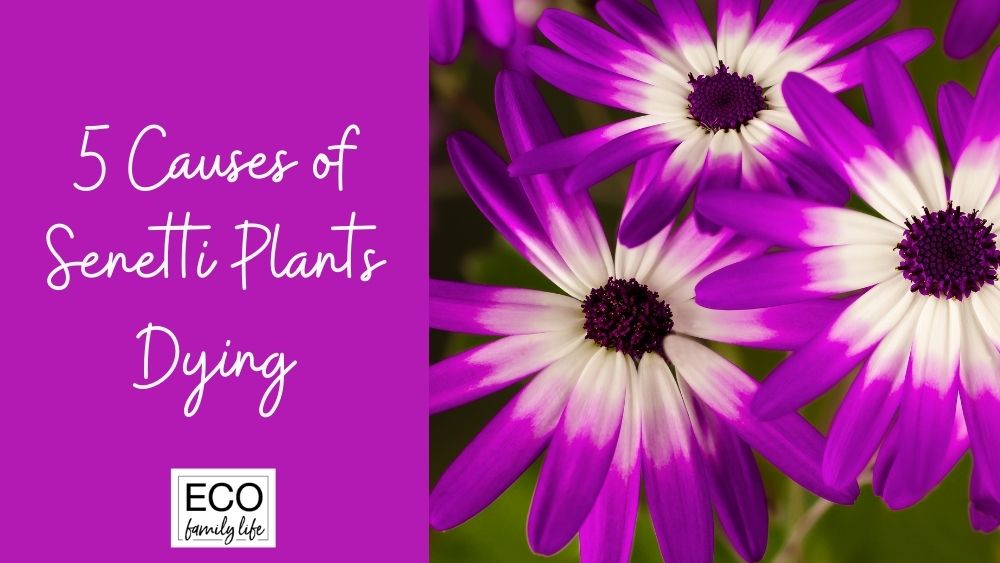Senetti plants have vibrant colors and look great over spring and summer. Senetti also help with pollination and look great in anyone’s garden. Senetti plants can be tricky if you haven’t grown them before. Problems arise if they are not getting enough sunlight, if they get too much hot, afternoon sun, fluctuations in the temperature, or sap sucking pets.
This article will explore the top 5 causes of a senetti dying and what you can do to save your plant.

1. Issues with Watering
Lots of problems can be caused from watering the plant improperly. For senetti, you can water them twice a week and they’ll be fine. You can stick your finger in the soil to determine if the plant needs to be watered, and if the first few inches on top of the soil are dry, go ahead and water it.
If there is dampness in the first few inches of the soil, wait another day or two. In addition, you need to have both well-draining soil and a pot that has holes drilled into it. These two things help make the most of the water you do provide to the plant and help it work more efficiently.
Senetti can be overwatered easily and I did this to mine for the first few weeks. They will develop black leaf tips which can spread further.

The soil should be wet but not soggy. Watering problems can cause the leaves to turn brown and give them a dull look. Often, you can actually revive the plant reducing your watering schedule.
Finally, when it comes to watering your senetti plants, try to avoid watering them in the morning or evening hours when it’s cold outside. This is because the water itself will be cold and the plant can suffer a shock.
For the best results, water the plants in the afternoon when the soil and water should be warmer. Again, the soil needs to be moist but not soaking wet. You should never overwater or underwater your senetti plants.
2. Issues with Sunlight
Senetti plants can die quickly if they are exposed to hot sun in the afternoon. They need protection from the afternoon sun and can burn quickly if they go from a shaded garden center to a sunny spot in your garden.
Senetti can continue to grow throughout the year if they are given the conditions they need.

Keep in mind that the more sunlight the senetti plant gets, the more colorful the flowers will be, so a good amount of morning sunlight is necessary for this type of plant.
If the blossoms on your senetti plant aren’t showy enough for you, it could be that it isn’t being given the right amount of light.
3. Fluctuations in Temperature
Senetti plants prefer cooler, mild temperatures and can burn hot summer sun. They can survive in almost all conditions, but they always prefer cooler temperatures. In the summertime, it’s good to keep them in the shade or indirect sunlight, just to make sure it doesn’t get too hot for them to thrive.
Once it gets below 50 degrees Fahrenheit, the flowers will start to bloom, which is why indirect sunlight or shade works best for them during the summer months. Heat is fine but direct sunlight during the summer months is usually a bit much for them to survive.

4. Pest Problems
Senetti can suffer if they are attacked by pests. For instance, if you see worm-like trails on the plant’s leaves, it is likely pests known as leafminers, which lay eggs on the leaves that turn into larvae.
Then the larvae feed on the leaf tissue of the plant. Eventually, the larvae turn into pupae and fall into the soil so they can spread into your neighboring plants. If the infection doesn’t look bad, cut off the affected leaves and discard them.
If the pupae are in the soil already, don’t bother to cut the leaves. Instead, spray neem oil directly on the plants as soon as you notice the problem. You can also use an insecticide if you like, and both of these methods can eliminate any existing larvae. You can even introduce natural predators to get rid of the problem.
5. Fungal Infections
Several problems with senetti plants are caused by fungal infections. If you notice that the leaves have spots on them that are dark brown or black, it is usually caused by a fungal infection called alternaria leaf spot.
This infection can soon infect the entire leaf. To get rid of it, just get rid of the infected leaves without getting the leaves wet. Then apply fungicide afterwards in order to protect the healthy plants that surround the infected ones.

If you find yellow spots on the leaves, it is often a fungal infection called downy mildew. This infection is usually seen on the underside of the leaves, and you can eliminate it by removing the infected leaves, then watering the base of the plant. In this situation, avoid watering on the leaves themselves.
Conclusion
Senetti plants are a joy to own, but they can still present you with some challenges along the way. If your senetti plants are dying or having their growth stunted due to problems or infections, the first thing you’ll need to do is determine what the problem is so you can come up with a solution.
The most common problems with senetti plants center around issues with watering, sunlight, the temperature, pests, and diseases and infections.
You don’t have to be a plant expert just to recognize problems with senetti plants. By simply paying them some attention you can usually figure out exactly what the problem is.
Happy growing
I am an accredited practicing dietitian, experienced gardener and a dedicated cook. I love writing and sharing my experience so you can learn from my successes and mistakes.
